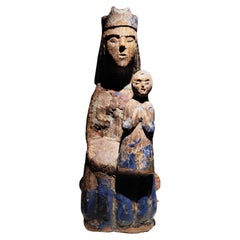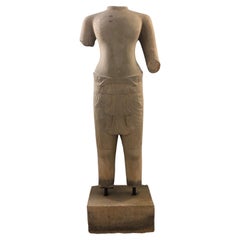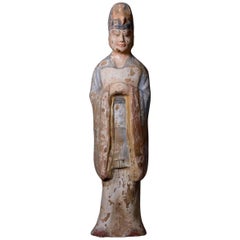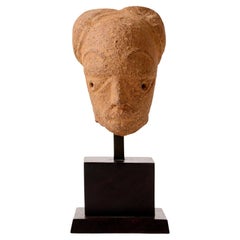15th Century and Earlier Figurative Sculptures
to
26
202
1,143
3,742
9,085
2,755
2,268
3,213
2,043
301
151
563
566
255
489
567
674
382
268
1
67
62
59
37
17
110
85
69
67
44
37
31
Height
to
Width
to
202
202
202
1
1
Period: 15th Century and Earlier
Seated Virgin with Child (Sedes Sapientiae) from the 12th Century in Spain
Located in Madrid, ES
Technique: Tempera and oil on wood
Dimensions: 25 x 11 x 8 cm
Description:
This exceptional work from the 12th century represents the Seated Virgin with Child (Sedes Sapientiae), standing out as an artistic treasure from medieval Spain. The portrayal of the Virgin enthroned with the Child on her lap is emblematic of Romanesque art, and this particular piece is a valuable and authentic example of that era.
The current polychromy belongs to the Gothic period and overlays the original Romanesque layer. It is crucial to highlight that the current state of the artwork is the original, without any cleaning interventions, imparting a unique authenticity.
The work exhibits architectural characteristics typical of Romanesque art, evident in the sides of the throne. The rigidity and symmetry characteristic of this style are reflected in the firm presentation of the Baby Jesus, noticeable in his gesture while holding his son. The Virgin wears a crown, symbolizing her royal character as the Queen of Heaven and Creation. Both figures retain traces of polychromy on the face and attire, adding layers of history and authenticity.
While similar Romanesque Virgin...
Category
Antique 15th Century and Earlier Figurative Sculptures
Materials
Fruitwood
$7,386 Sale Price
20% Off
Grand Scale 15th Century Solid Hand Carved Stone Male Statue
Located in Larkspur, CA
Grand scale 15th century solid hand-carved stone male statue. Source of origin Bhutan.
Category
Antique 15th Century and Earlier Figurative Sculptures
Materials
Stone
Elegant Terracotta Standing Court Dignitary, Tang Dynasty, EU Passport
Located in San Pedro Garza Garcia, Nuevo Leon
Elegant Standing Court Dignitary with joined hands in blue robes and a bird headdress. Polychrome Traces.
When China was unified again, first briefly ...
Category
Chinese Tang Antique 15th Century and Earlier Figurative Sculptures
Materials
Terracotta
Ancient Nok Clay Sculpture from Nigeria
Located in Sagaponack, NY
Terracotta head remnant on tapered wood base
Category
Nigerian Antique 15th Century and Earlier Figurative Sculptures
Materials
Wood
Renaissance Marble Relief - Emilia Romagna, 1470-80
Located in Bruxelles, BE
Renaissance Marble Relief
Emilia Romagna, Faenza ? 1470-80
H 30,2 x L 33 x P 3,5 cm
The carved marble relief depicts the Virgin accompanied by a winge...
Category
Italian Renaissance Antique 15th Century and Earlier Figurative Sculptures
Materials
Marble
Set of Unknown Miniature Terracotta Heads
Located in Leuven , BE
This small head of a ceramic figure with a bird headdress is probably Pre-Columbian. It seems to originate from the territory of present-day Mexico. Fur...
Category
South American Antique 15th Century and Earlier Figurative Sculptures
Materials
Terracotta
$1,968 / set
Equestrian figure Koma-Bulsa, Ghana, 14th-15th century
Located in Paris, FR
Terracotta, 14th-15th century (thermoluminescence test: Interexpert 388317 from March 18, 1988).
Koma-Bulsa motifs (Ghana), including a concave hairstyle with braided frontal ornamen...
Category
Ghanaian Tribal Antique 15th Century and Earlier Figurative Sculptures
Materials
Terracotta
Ancient Terracotta Tanagra, 'Restored'
Located in Marseille, FR
Old Tanagra in terracotta (restored) 18 cm high.
Additional information:
Material: Terracotta
Dimension: 18 H cm.
Category
Antique 15th Century and Earlier Figurative Sculptures
Materials
Terracotta
Tile End Cap, Terracotta Ridge Cap, Han Period
Located in Saint ouen, FR
Tile end cap.
Terracotta ridge cap.
Han period.
Diameter 15 cm.
590€.
Category
Chinese Antique 15th Century and Earlier Figurative Sculptures
Materials
Terracotta
Followers of Jean de la Huerta, Jean de Blany ? - Saint Jerome
Located in Bruxelles, BE
Followers of Jean de la Huerta, Jean de Blany ?
Saint Jerome
Limestone
Burgundy, second half of the15th century
60,5 cm
ALR Ref : S00248050
This exquisite sculpture of Saint Jerome, carved from soft, nearly white limestone typical of eastern France, exemplifies the exceptional craftsmanship of 15th-century Burgundian art. The figure of Saint Jerome, a key figure in Christian history renowned for translating the Bible into Latin, is depicted wearing a cardinal’s hat and holding the Vulgate Bible...
Category
French Renaissance Antique 15th Century and Earlier Figurative Sculptures
Materials
Limestone
Christo Carved Stone Sculpture, France, 15th Century: Museum-Quality Masterpiece
Located in Madrid, ES
Immerse yourself in the majesty of 15th-century France with this significant Christo sculpture carved in stone and polychromed, a masterpiece capturing the artistic essence of the er...
Category
Antique 15th Century and Earlier Figurative Sculptures
Materials
Stone
$3,664 Sale Price
20% Off
Romanesque Telamon - Northern Italy, late 12th (Reemployed Roman marble)
Located in Bruxelles, BE
Telamon
Northern Italy, late 12th - early 13th century
Reemployed Roman marble
H 32 x L 18 x P 17 cm
« Sono coloro che hanno dimenticato che l’uomo é solo un bruco, destinato a dive...
Category
Italian Medieval Antique 15th Century and Earlier Figurative Sculptures
Materials
Marble
$23,858 Sale Price
20% Off
Medieval English Alabaster Statue
Located in Wormelow, Herefordshire
A medieval English alabaster statue, possibly dating as far back as the late 14th / early 15th century, mounted on one of our exclusive large display plinths. Well weathered over the centuries, this 600-year-old statue depicts a medieval cloaked figure, possibly a monk, offering a glimpse into English architecture and sculpture of the Middle Ages.
This sculpture is possibly made from Nottingham alabaster. During the 14th and 15th centuries, Nottingham was the centre of alabaster carving and painting. Alabaster works were mostly made as small alabaster models with religious themes. During the 16th century Reformation, many alabaster carvings were destroyed under King Henry VIII's rule, making any surviving examples even more significant.
Provenance
From the collection of Peter Hone (b. 1941). A master plaster caster, he is an expert and experienced collector, building up an extraordinary, museum-worthy collection of items in his one-bedroom flat in London W11...
Category
English Medieval Antique 15th Century and Earlier Figurative Sculptures
Materials
Alabaster
Large Hexagonale Base of Pilaster in Burgundy Stone, Burgundy, 15th Century
Located in Bruxelles, BE
Large base of molded hexagonal pilaster in burgundy stone carved with vines, grapes and rosettes in high relief.
Burgundy, 15th century
28 x 63 x 30 cm
Provenance : collection De...
Category
French Gothic Antique 15th Century and Earlier Figurative Sculptures
Materials
Stone
$6,203 Sale Price
20% Off
Rider, Polychrome Terracotta, Ming Period
Located in Saint ouen, FR
Rider.
Polychrome terracotta.
Ming period.
Removable head.
H 40cm. L 29cm. W 11cm.
1400€.
Category
Chinese Antique 15th Century and Earlier Figurative Sculptures
Materials
Terracotta
Cercle of Jacopo della Pila - Marble relief depicting a winged Cherub
Located in Bruxelles, BE
Cercle of Jacopo della Pila (Lombard, in Naples 1471-1502)
Marble relief depicting a winged Cherub
Naples, second half of15th century
40 x 57 x 12 cm
Exquisitely carved, this relief portrays a winged cherub with cascading hair and delicate features. The cherub's plump, smooth countenance, rounded cheeks, outlined lips, and finely drawn nose emanate a sense of tenderness. The quadrangular module, is adorned with a carved frame. The relief ascends gradually, transitioning from the low relief of the wings to the high relief of the head.
The rectangular frame and the subtly curved form of the artwork suggest that the relief likely adorned the upper part of an arch or a vaulted chapel. The type is that of the perspective room with a coffered ceiling decorated with figures of winged cherubs, which is found in various Neapolitan chapels of the 15th century. Coffered ceilings attest to the recovery of antiquity and the search for luxury in Renaissance architecture, first in Florence, then in Rome and Naples. The majority of the numerous family chapels and tombs built during the late fifteenth century in south of Italy employ the new formal vocabulary of the Florentine Renaissance in a self-confident manner that permitted a broad spectrum of variations.
The escalating admiration for the classical world, coupled with the development of perspective, significantly contributed to the Renaissance endorsement of coffered ceilings. This artistic and constructive device drew inspiration from the intricate marble patterns observed in historical landmarks such as the Arch of Titus, the Temple of Vesta in Tivoli, the Pantheon, and the Basilica of Maxentius. A distilled product of both mathematical and artistic cultures, deeply scrutinizing the ancient world, the coffered ceiling plays a vital role in the perspective construction of space with its regular and directional geometry. The motif of the coffered ceiling decorated with cherubs in relief was introduced in Naples by Francesco Laurana in the plastic decoration of the Arch of Castelnuovo. Laurana's impact on the art scene in the south of Italy was profound. The introduction of the winged cherub into the region's artistic vocabulary bridged the gap between the classical and the contemporary, creating a synthesis that resonated with both aesthetic and spiritual sensibilities. His influence extended beyond the immediate visual appeal, shaping the cultural identity of the Renaissance in southern Italy. Although the plastic decoration of the Arch of Castelnuovo cannot certainly be ascribed to a mature Renaissance style, it was precisely on this occasion that the sculptors who worked there could get to know and export throughout the Italian peninsula that type of "Florentine classicism" which, even in the 15th century Naples, was conditioned by the Burgundian culture imported into the Kingdom by Alfonso of Aragon himself, with artists called from Spain and Northern Europe. The coffered ceiling, with its geometric patterns and Laurana's winged cherubs nestled within, became a symbol of refinement and cultural sophistication. The relief sculptures, carefully integrated into the overall design, transformed the ceiling into a celestial realm, inviting viewers to contemplate the divine while immersed in the grandeur of the Renaissance space.
Similar winged cherubs appears also in the Naples cathedral. Within the renowned Succorpo Chapel, a mesmerizing marble coffered ceiling adorned with cherubs epitomizes the splendor of the Neapolitan Renaissance. The interplay of light and shadow on the textured surface of the marble coffered ceiling introduces an ethereal dimension, providing an immersive visual experience for observers. The geometric precision and the repeated patterns, reminiscent of classical motifs, establish a sense of harmony and balance that has become the hallmark of the Neapolitan interpretation of Florentine Renaissance aesthetics.
Although probably intended to be admired from a distance, this cherub is intricately detailed and exquisitely rendered: the face and hair are elegantly outlined and the feathers are textured through juxtaposed lines. The marble, both figurative and decorative, adheres to the principles of balance and restrained ornamentation typical of the « Florentine Classicism ». Harmonious shapes and gracefully orchestrated curves , rooted in the classical repertoire, converge to evoke a sense of ethereal beauty. The surface displays the masterful use of a chisel to intricately carve the feathers and facial features, creating an almost abstract quality.
This work is a testament to a sculptor of great skill and rich figurative knowledge, seamlessly blending classical firmness in contours with a refined treatment of the marble's surface. The combination of tradition and innovation point to a stylistic idiom from Lombardy, in particular we can find some comparaisons with the works of Jacopo della Pila, sculptor of Lombard origin working in Naples in the second half of the 15th century. He is documented there between 1471 and 1502, and is a protagonist of the Aragon Renaissance in the second half of the Quattrocento, together with the other great Northern sculptor active in the kingdom, Domenico Gagini.
the first commission he received dates back to August 9, 1471, when Jacopo publicly committed to sculpting the funerary monument of Archbishop Nicola Piscicelli to be placed in the Cathedral of Salerno. The last known work is an altar ordered on July 29, 1502, by the noble Jacopo Rocco for the church of San Lorenzo Maggiore in Naples. Between these two chronological extremes (1471-1502), we must place the fervent activity of the artist, who had trained in Rome, perhaps under the guidance of Paolo Romano but also engaged in dialogue with other major artists of the city, especially Isaia da Pisa. He enriched his experience in Naples, initially drawing inspiration from the works of Domenico Gagini and later from the Tuscan masterpieces of Antonio Rossellino and Benedetto da Maiano destined for the church of Santa Maria di Monteoliveto. Jacopo della Pila's artistic personality is thus based on a complex interplay of influences, contributing to the definition of a highly personal style.
Close comparaison can be made between our cherub and the winged angels reliefs...
Category
Italian Renaissance Antique 15th Century and Earlier Figurative Sculptures
Materials
Marble
$22,903 Sale Price
20% Off
San Antonio Abad, Spanish School of the 15th Century '1440-1501'
Located in Madrid, ES
San Antonio Abad, Castilian school of the 15th century (1440-1501)
Carving in polychrome wood, measures: 45 x 15 cm
good vintage conditions.
Category
Spanish Gothic Antique 15th Century and Earlier Figurative Sculptures
Materials
Wood
$3,531 Sale Price
20% Off
South Coast Wood Ceremonial Leeboard with Open Lattice Designs, Ex-Sotheby's
Located in San Pedro Garza Garcia, Nuevo Leon
A South Coast wood ceremonial leeboard, Ica Valley region, Late Intermediate Horizon, ca. A.D. 1100-1400.
This large 'remo' made from the hard algarrobo wood, features twelve figure...
Category
Pre-Columbian Antique 15th Century and Earlier Figurative Sculptures
Primitive Head Figure From the Pre-Columbian Period Made of Stone
Located in North Miami, FL
Introducing a remarkable artifact from the Pre-Columbian period—a primitive head figure intricately carved from stone. This ancient relic stands proudly...
Category
Pre-Columbian Antique 15th Century and Earlier Figurative Sculptures
Materials
Stone
$2,963 Sale Price
24% Off
Republic of Mali Terracotta Figure of a Female Ancestral Figure
Located in West Palm Beach, FL
Republic of Mali terracotta figure of a female ancestral figure.
kneeling with her feet under her, arms to her shoulder,
circa AD 1100 - 1400
Measures: Height 9 1/2 in. 24.1 cm.
...
Category
Antique 15th Century and Earlier Figurative Sculptures
Materials
Terracotta
Renaissance Era, Marble Fragment of a Leg
Located in Los Angeles, CA
Chic, 15th Century, Roman marble fragment of a left foot and calf mounted on a custom iron stand.
Category
Italian Renaissance Antique 15th Century and Earlier Figurative Sculptures
Materials
Carrara Marble
Rider 2, Polychrome Terracotta, Ming Period
Located in Saint ouen, FR
Rider.
Polychrome terracotta.
Ming period.
H 30cm. L 27cm. W 11cm.
1200€.
Category
Chinese Antique 15th Century and Earlier Figurative Sculptures
Materials
Terracotta
Recently Viewed
View AllMore Ways To Browse
Lucite Head Sculptures
Roman Soldier Bronze Sculpture
Italian Angel Statues
Lead Figurines
Marble Girl Nude
Miguel Berrocal Puzzle Sculptures
Narcissus Bronze
Narcissus Sculpture
Pharaoh Statue
Roman Centurion
Vendome Marble
Vintage Car Mascots
Vintage Mannequin Head
Wood Stump Sculpture
A Fayral
Alcove Sculptures
American Indian Statue
Angels Playing Instruments





